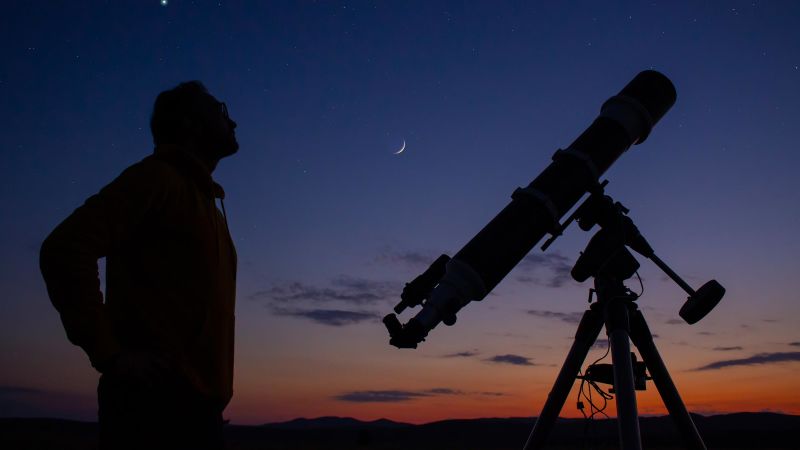In the picturesque month of February, an extraordinary phenomenon unfolds across the nocturnal canvas of the sky that delights astronomy enthusiasts and casual stargazers alike. A celestial dance featuring seven distinct planets is scheduled to take place, with notable participants including Mercury, Uranus, and Neptune, alongside the more prominent planets such as Mars, Venus, Jupiter, and Saturn. However, experts caution that witnessing all seven planets in their magnificent alignment will present some challenges, particularly in terms of visibility.
As the sun dips below the horizon, all seven planets will be positioned in the twilight, but locating Mercury and Saturn may prove to be especially daunting during the evenings of Thursday and Friday. Shannon Schmoll, who serves as the director of the Abrams Planetarium at Michigan State University, explains that both Mercury and Saturn reside close to the sun, rendering them susceptible to its glare. She reassures us, however, that as days progress, Mercury will ascend higher in the sky, becoming easier to spot. Observers are advised to take advantage of binoculars and seek a clear view toward the western horizon just after sunset to increase their chances of spotting these elusive planets.
Among this stellar ensemble, Venus and Jupiter are likely to be the standout features of the night sky, thanks to their exceptional brightness. Mars, identifiable by its signature reddish-orange hue, will also attract attention with its distinct coloring, further enhancing the spectacle. Conversely, the more distant planets, Neptune and Uranus, are challenging to view without optical assistance, such as telescopes or high-powered binoculars.
This month marks an unusual occurrence where numerous planets are visible in the night sky. The reason for this alignment lies in the orbits of the planets around the sun, as they traverse along a flat plane known as the ecliptic. As Earth rotates and orbits the sun, certain conditions arise that allow for multiple planets to be in close proximity. In February, these planets occupy a shared area of the solar system from our viewpoint on Earth, leading to a spectacular sight.
Astronomers like Marcy Curran, an editor at EarthSky, refer to Mercury and Saturn as “horizon huggers” due to their low positioning on the horizon at sunset. To catch a glimpse of these planets, observers should look around 30 minutes after sunset, aiming for the western horizon. Uranus and Neptune will be present as well, but their positions are higher in the sky and may not be discernible until darkness fully envelops the surroundings.
Towards the southwest, observers can anticipate the locations of Saturn and Mercury, while Mars and Jupiter will dominate the southeastern region of the night sky. For those unsure where to direct their gaze, EarthSky contributor John Goss suggests using Venus as a guiding star. Known for its brilliance, Venus will take center stage in the western sky but will gradually sink lower toward the horizon, disappearing from view by mid-March, only to re-emerge in the morning sky come April.
As twilight reaches its end at about 6:58 p.m. ET on Fridays, the ‘Cheshire moon’ will make its entrance, offering an enchanting view. This crescent moon has drawn its whimsical name due to its resemblance to the grin of the Cheshire Cat from Lewis Carroll’s famed “Alice’s Adventures in Wonderland.” Furthermore, according to Hawaiian mythology, the phase is referred to as the ‘wet moon’ because of its resemblance to a holder for liquids.
Expected to be visible just above the western horizon, the crescent moon will only linger for a few moments before it sets beneath the horizon. In the coming days, Mercury will progressively ascend in the sky following sunset, riding higher each evening. Venus will also maintain its presence, possibly inspiring awe under the nighttime sky.
Through Sunday, observers will continue seeing the lineup of the crescent moon, Venus, and Mercury. Curran encourages prioritizing Venus during this cosmic celebration, as its brightness makes it the most noticeable celestial body. Goss predicts that both Jupiter and Mars will remain observable for several months to come, offering stargazers ample opportunity to appreciate the beauty above.
For those faced with cloudy conditions obstructing their views, the Virtual Telescope Project, located in Manciano, Italy, is prepared to broadcast live streams from its robotic telescopes, allowing enthusiasts to experience the phenomenon despite the weather challenges.
In summary, February not only serves as a treat for sky enthusiasts with a mesmerizing planetary parade but also highlights the delicate dance of celestial bodies around the sun, mesmerizing amateur and seasoned astronomical observers alike. The unique alignment presents a rare opportunity to witness planetary beauty, provided one takes the time to prepare and seek out optimal viewing conditions.



